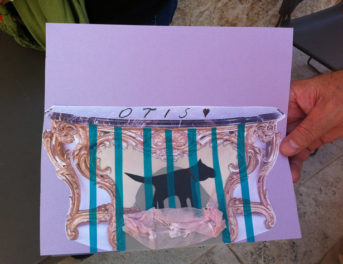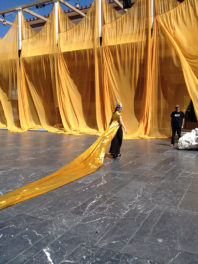
Ants in the Northumberland Bestiary, about 1250–60, unknown illuminator, made in England. The J. Paul Getty Museum, Ms. 100, fol. 23. Digital image courtesy of the Getty’s Open Content Program
Meet 19 animals of the medieval bestiary in Book of Beasts, a blog series created as part of an history seminar taught by UCLA professor Meredith Cohen. The posts complement the exhibition Book of Beasts at the Getty Center from May 14 to August 18, 2019. Getty Museum curator Larisa Grollemond contributes the first entry, introducing us to the fearsome medieval ant. —Ed.
The medieval bestiary includes animals large and small, real and imaginary, ordinary and exotic. And while ants might not be the first “beasts” you think of when you imagine a book of medieval animals, there’s more to these tiny creatures than meets the eye.
Created in the European Middle Ages, the bestiary is a type of illuminated manuscript that interprets animals through the lens of Christian belief. Many manuscripts of this type have survived from throughout the medieval period, and many of them are the most lavishly illustrated volumes in European book history. In the bestiary, animals are presented not merely as zoological specimens, but as lessons for moral behavior. The spiritual lesson of the ants is that they work together toward a common goal and therefore serve as an example for men, who should also work in unity with each other and God.
Ants are said to have a soldier-like comportment, carrying grains in their mouths, and they are able to tell the difference between their food and barley, which is eaten by cattle. This distinction is symbolic of the judgment Christians must make in distinguishing the spiritual meaning of the Bible from its literal one. Barley is therefore the heresy Christians must reject in their path to salvation.
The imagery associated with ants in bestiary manuscripts supports these interpretations, showing them simply and even naturalistically, as tiny brown or black segmented bodies with tiny legs. The typical bestiary entry for ants describes the behavior that we know to be true for ants: they walk in lines to gather food, carry very heavy weights, and live in collaborative and well-organized communities. Usually they are shown building an anthill, marching along in orderly rows.
Seems pretty straightforward, right? That’s where you’d be wrong, because some bestiaries also describe a more dangerous creature known as the “ant-lion” due to its predilection for hiding in the sand and killing ants that are carrying grain. To other ants, it is a lion—but it is still a tiny creature and thus an ant to most other animals.
There are also ants that, according to some bestiaries, live in Ethiopia or India, are the size of dogs, and dig up gold from sand, guard it, and pursue anything that tries to steal it, especially greedy humans. Artists depicted these ants not as larger versions of the familiar-looking insects, but more like actual dogs.
One example of an oversized ant comes from the margins of an early-fourteenth-century manuscript known as the Queen Mary Psalter. A devotional (prayer) book, this book of Psalms isn’t a bestiary but includes many images drawn from the bestiary tradition to complement its texts, encouraging viewers to make connections between the animal stories and the prayers within. This artist shows the fierce Ethiopian ants as small dogs on top of their mound of gold, defending it from two men who attack them, swords raised.

Ants (detail) in the Queen Mary Psalter, about 1310–20, unknown illuminator, made in England, possibly London/Westminster or East Anglia. Pigment on parchment, 27.5 x 17.5 cm. The British Library, Ms. Royal 2 B VII, fol. 96. Digital image: British Library
The case of the gold-digging, dog-sized ants of Ethiopia is an especially interesting case study for how stories can travel through history and reach new audiences in new languages. The source for the story may originate in the Hindu epic the Mahâbhârata (written around 1000 BCE), which makes reference to ants that excavated gold, but is also recounted in the writings of ancient Greek historian Herodotus (about 430 BCE) and other ancient texts. From here, the story made its way into the medieval bestiary.
The tale of the monstrous ants was also included in medieval texts other than the bestiary, especially travel narratives. For example, Sir John Mandeville supposedly journeyed far to the east and reported having seen various fantastic animals and so-called “monstrous races” described in multiple bestiaries. Modern scholars have argued that historical authors merely confused these “monster ants” with real creatures such as mongooses or marmots that actually do dig up soil with gold in it. But either way, the story of the gold-digging ants persisted.
The story of the ferocious Ethiopian ants demonstrates the medieval willingness to believe in the imaginary, especially when located in far-flung and mysterious lands. It also illustrates what to the modern eye seems like a mix of fantasy and science that we find in the medieval bestiary.
It’s tempting to laugh about the gullibility of centuries-old readers who marveled at illuminations of ants the size of dogs. But are we really so different? Images still fuel our beliefs about places we’ve never been and creatures we’ve never seen—and in this way, we aren’t so different from the medieval reader. Perhaps the lessons of the bestiary are still applicable. We still might have something to learn from ants (the regular type, at least) about working together for the greater good.
See all posts in this series »





Charming and brilliant – so near and so far. I’m (at age 72) auditing several medieval history courses, including books and these sorts of illustrations. We (a class of 30 +/-) recently spent time in the U. Pittsburgh rare books collection, examining similar illustrations. Perhaps we can get our (terrific) professor a small grant to come to LA.